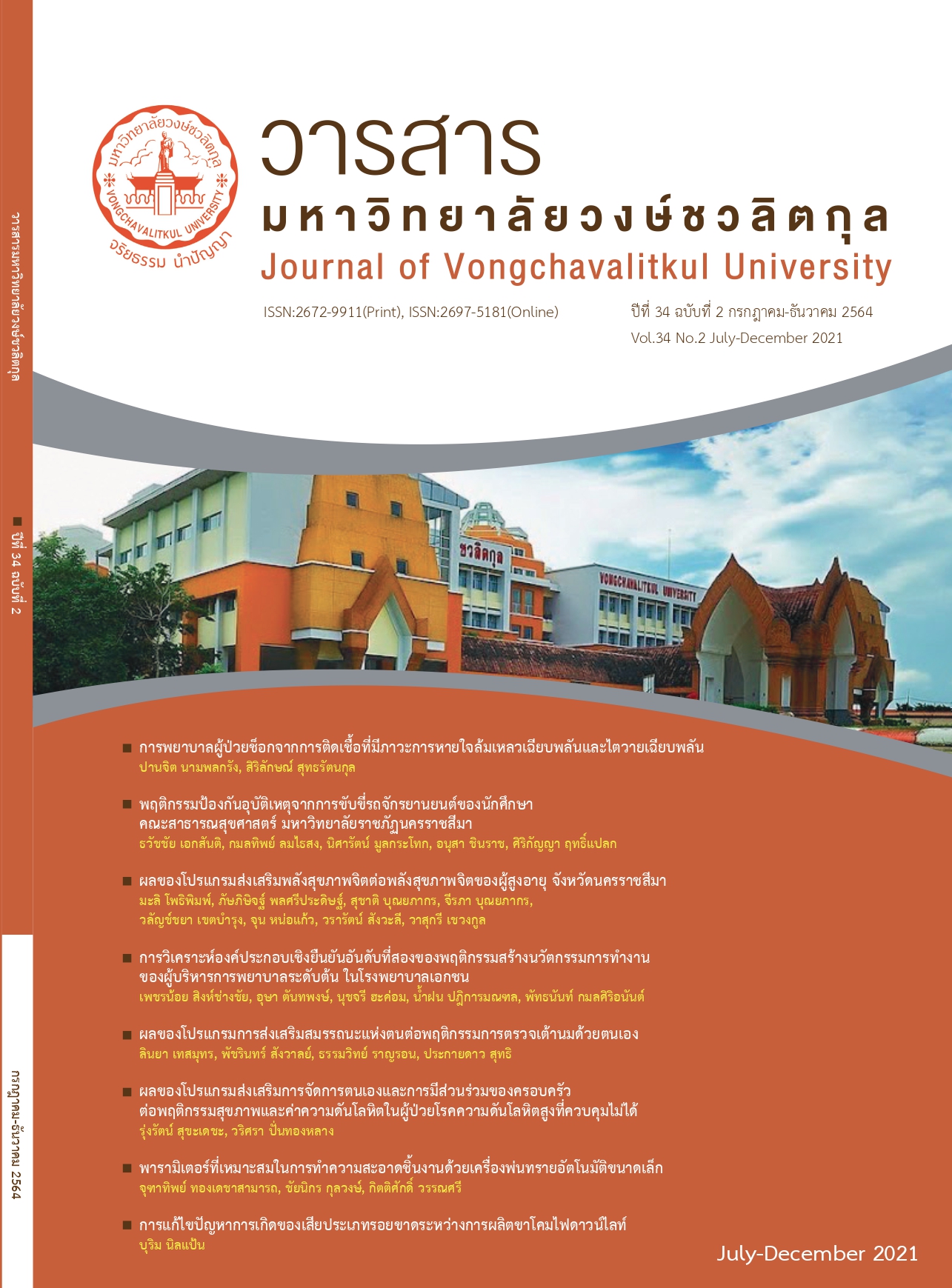Second Order Confirmatory Factor Analysis of an Innovative Work Behavior for First-line Nurse Managers in Private Hospitals
Main Article Content
Abstract
Objectives: To analyze and to test construct validity using second order confirmatory factor analysis of innovative work behavior of first-line nurse managers in private hospitals
Method: A descriptive research with a sample group of 200 first-line nurse managers in private hospitals recruited through stratified sampling. The research instrument was a five-point rating scale questionnaire on innovative work behavior with content validity index of 0.80 and Cronbach’s alpha coefficient of 0.85. Descriptive statistics, first order confirmatory factor analysis and second order confirmatory factor analysis were conducted.
Results: When tested with second order confirmatory factor analysis, it was found that the construct validity of innovative work behavior of first-line nurse managers in private hospitals corresponded to the empirical data and the statistical values showed significant congruence with the criteria (c2 2nd order=42.04, df=61, p-value=0.96, RMSEA=0.00, GFI=0.92, AGFI=0.92, CFI= 1.00, NFI=0.95, RMR=0.015). There were 4 factors and 13 indicators with factor loadings that met the criteria (λ=0.63-0.75) consisting of innovative idea- exploration behavior (3 indicators), innovative idea-generation behavior (3 indicators), innovative Idea -championing behavior (4 indicators), and innovative idea-implementing behavior (3 indicators).
The research results indicate that administrators should have a reliable measuring tool with valid construct for assessment or measurement of innovative work behavior of first-line nurse managers. This is to assess potential of people management to encourage them to have innovative work behavior or to create new things using talent management that would results in more innovations in nursing organizations.
Article Details
References
กองการพยาบาล กระทรวงสาธารณสุข. (2561). แนวทางการจัดเก็บตัวชี้วัดการพัฒนาคุณภาพ. บริการพยาบาล ประจําปีงบประมาณ 2561. นนทบุรี: บริษัทสำนักพิมพ์สื่อตะวันจํากัด.
เพชรน้อย สิงห์ช่างชัย. (2562). ภาวะผู้นําด้านนวัตกรรมสําหรับการบริหารการพยาบาล. วารสารเครือข่าย วิทยาลัยพยาบาลและ การสาธารณสุขภาคใต้, 6(1), 260-267
สำนักการพยาบาล สานักงานปลัดกระทรวงสาธารณสุข กระทรวงสาธารณสุข. (2555). ยุทธศาสตร์การบริการพยาบาลระดับประเทศ พ.ศ. 2556-2560. นนทบุรี: องค์การสงเคราะห์ทหารผ่านศึก.
Anderson, N. R., Dreu, C. K. W. & Nijstad, B. A. (2004), The routinization of Innovation research: a constructively critical review of the state-of-the-science, Journal of Organizational Behavior, 25(2), 147-174.
Asurakkody, T. A. & Shin S. Y. (2018). Innovative behavior in nursing context: Asian Nursing Research, 12, 237-224.
Bass, B. M., & Riggio, R. E. (2006). Transformational leadership. Mahwah, NJ: L. I Lawrence Erlbaum.
Brislin, R. W. (1986). The wording and translation of research instruments. In W. J. Lonner & J. W. Berry (Eds.). cross-cultural research and methodology series, Field methods in cross-cultural research. Thousand Oaks. CA. US: Sage Publications. 137-164.
Burns, J. M., & Grove, S. K. (2001). The practice of nursing research, conduct, critique, and utilization (4thed.). Philadelphia: W. B. Saunders.
De Jong, J., & Hartog, D. (2008). Innovative Work behavior: Measurement and validation. EIM Business and Policy Research report. Netherlands: Amsterdam Business School.
De Jong, J., & Hartog, D. (2010). Measuring innovative work behavior. Creativity and innovation management, 19, 23-36. DOI:10.1111/j.1467-8691.2010.00547.
Gupta, K. K., Attri, J. P., Singh, A., Kaur, H., & Kaur, G. (2016). Basic concepts for sample size calculation: Critical step for any clinical trial. Saudi Journal of Anaesthesia, 10(3), 328–331. doi:10.4103/1658- 354X.174918.
Hair, J. F., Black, W. C., Babin, B. J., & Anderson, R. E., (2010). Multivariate data analysis: A global perspective. New Jersey: Pearson Prentice Hall.
Janssen, O. (2000). Job demands, perceptions of effort-reward fairness and innovative work behaviour. Journal of Occupational and Organizational Psychology, 73(3), 287-302.
Kaya, N., Turan, N., & Aydin, G. O. (2016). Innovation in Nursing: A Concept Analysis. Journal of Community & Public Health Nursing, 2(1), DOI:10.4172/2471-9846.1000108.
Mabrouk, R., Rahman. R. I., & Farghaly, S. M. (2019). Application of Optimis’ Talent Management Model for Head Nurses on Nurses’ Job Crafting and Innovation. IOSR Journal of Nursing and Health Science, 8(5), 81-95
Marquis, B. L. & Huston, C. J. (2017). Leadership Role and Management Function in Nursing: theory and application. (9th ed.). Philadephi, PA: Lippincott, William, & Wilkins.
Weng, M. H., Ha, J. L., Wang, Y. C. & Tsai, C. L. (2012). A study of the relationship among service innovation customer value and customer satisfaction: an industry in TAIWAN. International Journal of Organizational
Innovation, 4(3), 98-112.
Wuttirakkajon, N. (2017). Private Hospital Business: Analysis of Industry Update. Government Savings Bank Research Center for Economy Business and Fundamental Economy. Retrieved from https://www.gsb.or.th/getattachment/
Xerri, M . (2013). Workplace relationships and the innovative behavior of nursing employees: a social exchange perspective. Asia pacific Journal of Human Resources, 51(1), 102-123.
Zhou, J. & Shalley C. E. (2003). Research on employee creativity: A critical review and proposal for future research directions, In: Martocchio, J. J. & G. R. Ferris, Research in personnel and human resource management, Oxford: Elsevier.
Zhou, J. & George, J. M. (2001). When job dissatisfaction leads to creativity: encouraging the expression of voice, Academy of Management Journal, 44, 682-696.


